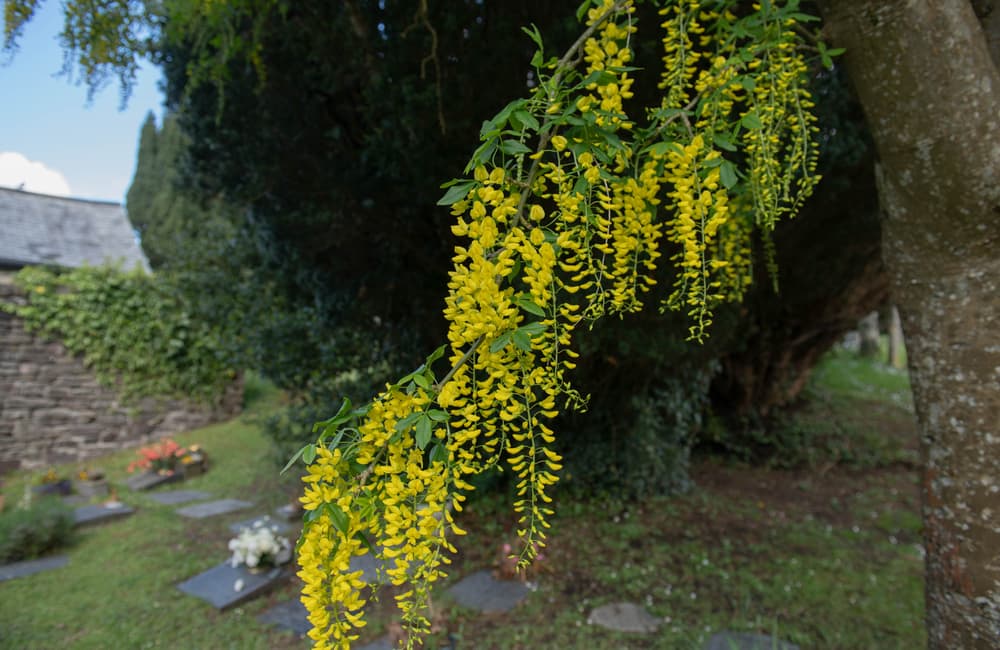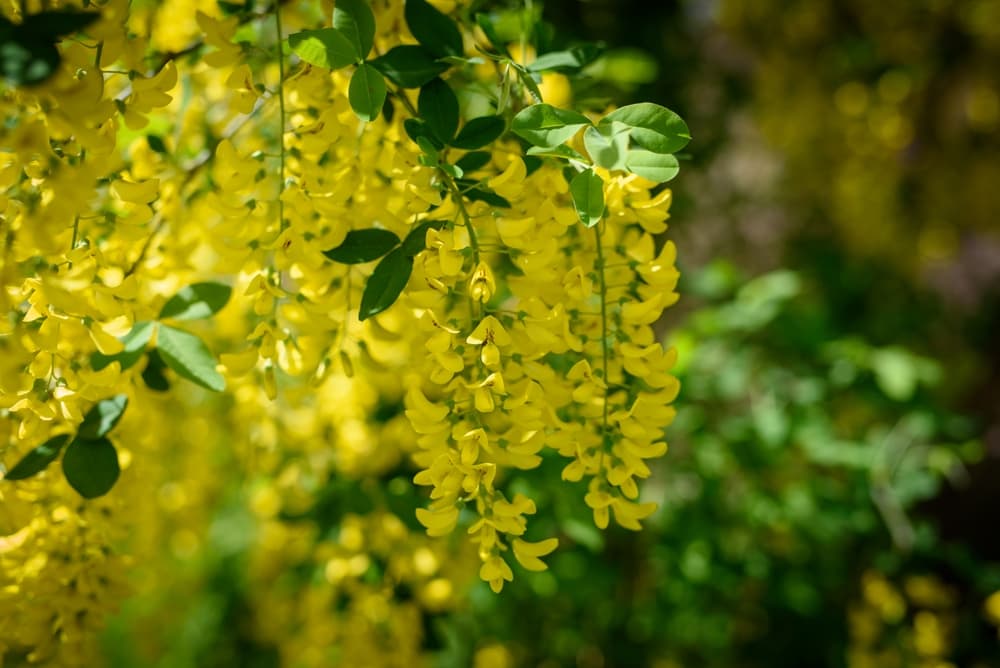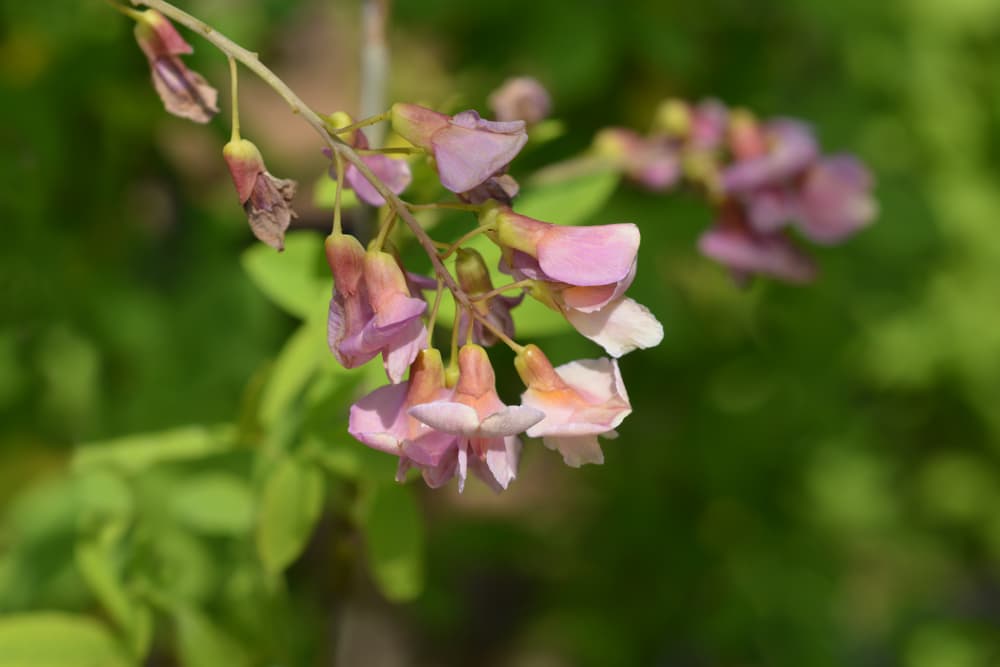Reviewed By COLIN SKELLY

Colin is a Horticulturist and Horticultural Consultant with experience in a range of practical and managerial roles across heritage, commercial and public horticulture. He holds the Royal Horticultural Society’s Master of Horticulture award and has a particular interest in horticultural ecology and naturalistic planting for habitat and climate resilience.
IN THIS GUIDE
LABURNUM GUIDES
Varieties
Laburnums are native to a belt of Western and Southern Europe from France and Germany through Italy and Greece to Romania, and spanning the Alps and the Balkans.1Laburnum anagyroides. (n.d.). Missouri Botanical Gardens. Retrieved March 20, 2023, from https://www.missouribotanicalgarden.org/PlantFinder/PlantFinderDetails.aspx?taxonid=280634
It arrived in the United Kingdom in 1560 and quickly established itself as a desirable ornamental tree.2Common laburnum. (n.d.). The Wildlife Trusts. Retrieved March 20, 2023, from https://www.wildlifetrusts.org/wildlife-explorer/trees-and-shrubs/common-laburnum
Genus Laburnum is a member of Family Fabaceae – the Pea Family or Legume Family.3Laburnum. (n.d.). Kew Royal Botanic Gardens. Retrieved March 20, 2023, from https://powo.science.kew.org/taxon/urn:lsid:ipni.org:names:22728-1
It has only three confirmed species: L. alpinum, L. anagyroides, and a common hybrid L. x watereri.

The last-named arose from a hybrid; however, nearly all Botanical and Dendrological authorities, including Kew and World Flora Online, name it as an accepted species.4Laburnum × watereri. (n.d.). Kew Royal Botanic Gardens. Retrieved March 20, 2023, from https://powo.science.kew.org/taxon/urn:lsid:ipni.org:names:501463-1
Also named within the genus are nearly 50 unresolved and little-known species plus several hybrids and cultivars nearly all of which have come and gone with the seasons.
Both L. alpinum and L. anagyroides when grown as trees attain heights from 4-8m, reaching ultimate heights after about 20 years.
Their spreads too are from 4-8m.
1) L. alpinum

L. alpinum is also called ‘Scotch laburnum’ or ‘Scottish laburnum’ but not because it is ’Scottish’!
Apparently the Scots appropriated the tree and somehow named it because they valued – and continue to value – its wood, and particularly its heartwood, for – among other uses – making bagpipes.
2) L. anagyroides

In contrast, poor L. anagyroides is only called ‘Common laburnum’!
Both species bloom in late May and the beginning of June. L. alpinum racemes, at 35-40cm, are very long compared to those of L. anagyroides which are 15-20cm.
On the other hand, L. anagyroides racemes are denser and thicker.
Another point of difference is the foliage. L. alpinum’s leaves are a crisp dark green whereas those of L. anagyroides are a dull greyish-green.
The former’s leaves are glabrous or smooth while the latter’s have fine downy hair on the underside.
Among the numerous cultivars that have come and gone, one stands out for each of the species.
3) L. alpinum ‘Pendulum’
So named because its branches are pendulous, which enhances the ‘dangling gold chain’ effect when the tree is in bloom and the ‘weeping’ boughs move in the wind.
Another reason it stands out is that it is a dwarf variety reaching an ultimate height and spread, both, of only 1.5-2.5m.
4) L. anagyroides ‘Sunspire’
Also a dwarf but it has a narrower, fastigiate form, attaining an ultimate height of 2.5m with a spread of (only) 1m.
Like its parent, the racemes are short but dense.
Upon emerging the racemes are erect and stay erect for about a fortnight.
5) L. watereri

Hybrids arose naturally from the two ‘main’ species, including in the UK, and they are collectively called L. watereri.
6) L. × watereri ‘Vossii’

However, the most desirable and most well-known Laburnum is a cultivar, L. × watereri ‘Vossii’.
It is the only Laburnum variety to have received the RHS’s Award of Garden Merit.
“It is popular for a reason and its AGM status proves the point,” adds Colin Skelly, a Master Horticulturist.
“I have planted the species in gardens where species have been preferred, but the vigour and floral impact of ‘Vossii’ means that this is the choice selection for most gardens.”
A ‘watereri’ hybrid that occurred in the wild in the Tyrolean region was found in the 1850s and brought to the Netherlands where ‘Vossii’ was cultivated from it in the late 1800s.
Like its parent species, it attains an ultimate height and spread of 4-8m.

Overall, ‘Vossi’ exhibits a few characteristics of each parent.
Consider: both the young stems and leaflets are initially pubescent but become glabrous as they mature.
In general, ‘Vossii’ brings together the best attributes of each parent and introduces a couple of new ones.
It produces far fewer seed pods, each of which has fewer seeds.

Even the foliage is a more appealing shade of green, being less grey and less dark.
As for the racemes, they are spectacular: the flowers’ hue is a rich golden yellow, they are dense and lush, and they are 50-60cm long.
The spectacle lasts from two to three weeks.
L. × watereri ‘Vossii’ is the most popular Laburnum variety in the UK and in other countries as well.
Other ‘Laburnums’
Giving some competition to the Laburnum is another ‘Laburnum’ – the ‘Indian Laburnum’, or Cassia fistula which is, obviously, a species of a different genus, Cassia.

Laburnum and Cassia trees do look quite similar in the flowering season when Cassia trees are also covered by a profusion of drooping, thick racemes of small, bright yellow flowers.
In fact, Cassia too is a member of the Family Fabaceae.5Fabaceae. (n.d.). Science Direct; Elsevier BV. https://doi.org/10.1016/b978-0-12-405927-6.00016-3
Cassia trees are of considerable cultural significance in Thailand, Laos, Sri Lanka, and India.
Besides Tropical East Asia, their native range spans the Equatorial and Tropical regions of Africa and South America.6Cassia bakeriana. (n.d.). Kew Royal Botanic Gardens. Retrieved March 20, 2023, from https://powo.science.kew.org/taxon/urn:lsid:ipni.org:names:484178-1

Evidently, these trees’ climate preferences are very dissimilar to the ones it is physically so similar to.
Among the many species, a good few are native to even some of the hottest regions of the planet.
For instance, Cassia sieberiana grows in Western Africa from Mauritania and Liberia to Nigeria.

Then there is a ‘Nepal laburnum’ – Piptanthus nepalensis, with the genus (Piptanthus) also being a member of the Fabaceae family.
This Himalayan native also puts on wonderful summer shows but its yellow-flowered racemes are only 4cm short.
However, it too is quite popular in European countries because, though its racemes’ length is a small fraction of those of even Laburnum anagyroides, what to speak of ‘Vossi’, unlike Genus Laburnum’s species, Piptanthus nepalensis is tough, pest-resistant and disease-free, and, therefore, low care.

Finally, we have “Adam’s laburnum”, with the botanical name Laburnocytisus ‘Adamii’.
This wonderful curiosity is a hybrid of Laburnum and Purple Broom with the result that in the spring flowering season, some branches are thick with yellow Laburnum racemes while other branches bear Purple Broom flowers!
References
- 1Laburnum anagyroides. (n.d.). Missouri Botanical Gardens. Retrieved March 20, 2023, from https://www.missouribotanicalgarden.org/PlantFinder/PlantFinderDetails.aspx?taxonid=280634
- 2Common laburnum. (n.d.). The Wildlife Trusts. Retrieved March 20, 2023, from https://www.wildlifetrusts.org/wildlife-explorer/trees-and-shrubs/common-laburnum
- 3Laburnum. (n.d.). Kew Royal Botanic Gardens. Retrieved March 20, 2023, from https://powo.science.kew.org/taxon/urn:lsid:ipni.org:names:22728-1
- 4Laburnum × watereri. (n.d.). Kew Royal Botanic Gardens. Retrieved March 20, 2023, from https://powo.science.kew.org/taxon/urn:lsid:ipni.org:names:501463-1
- 5Fabaceae. (n.d.). Science Direct; Elsevier BV. https://doi.org/10.1016/b978-0-12-405927-6.00016-3
- 6Cassia bakeriana. (n.d.). Kew Royal Botanic Gardens. Retrieved March 20, 2023, from https://powo.science.kew.org/taxon/urn:lsid:ipni.org:names:484178-1


